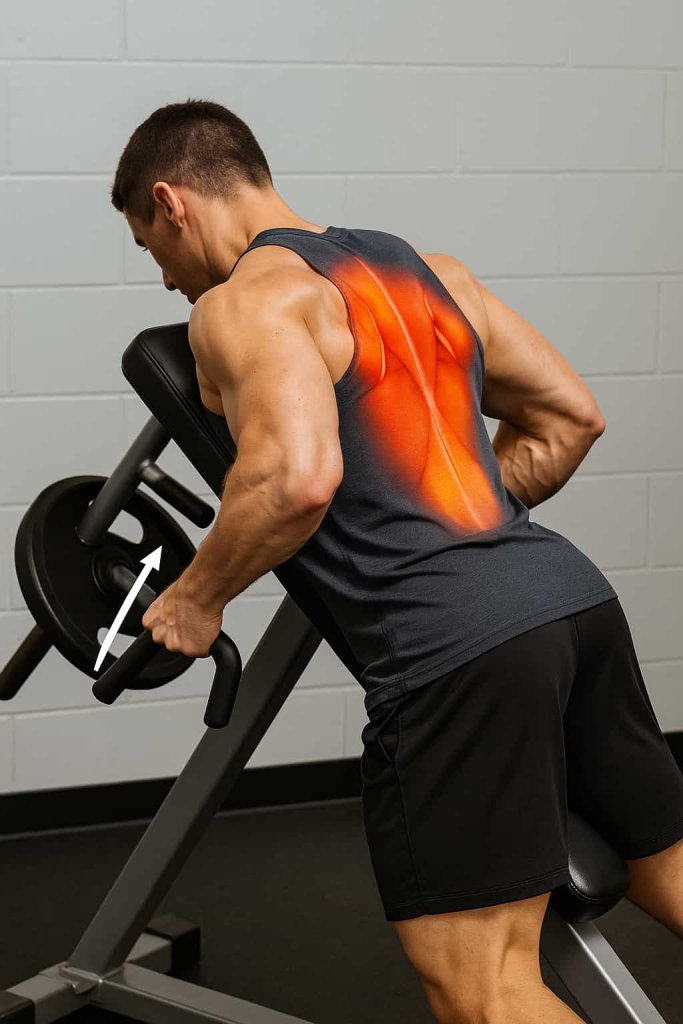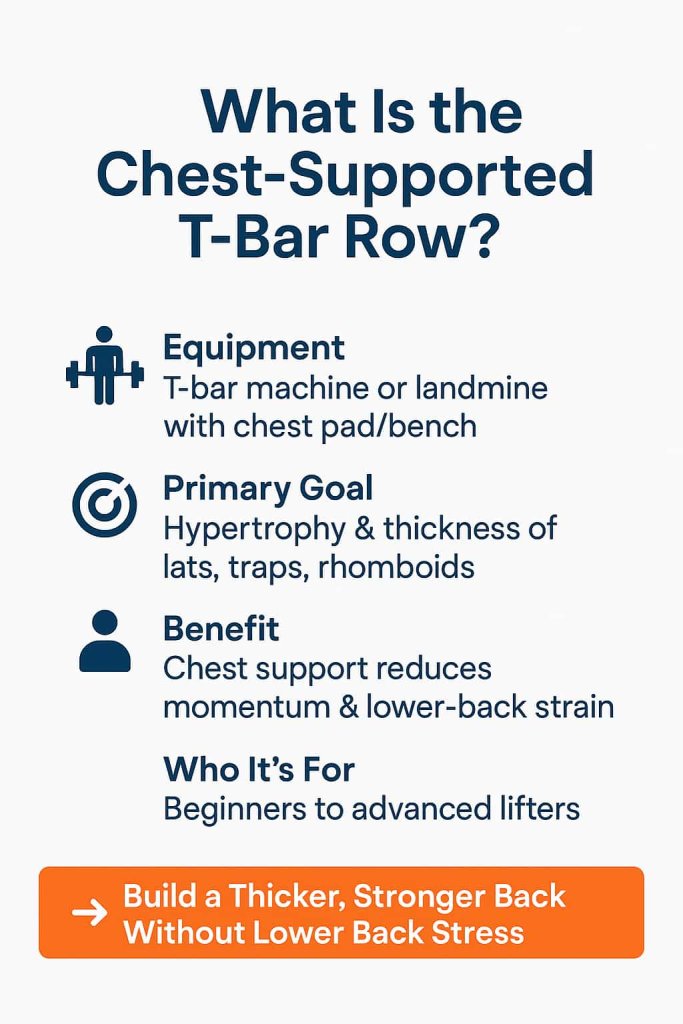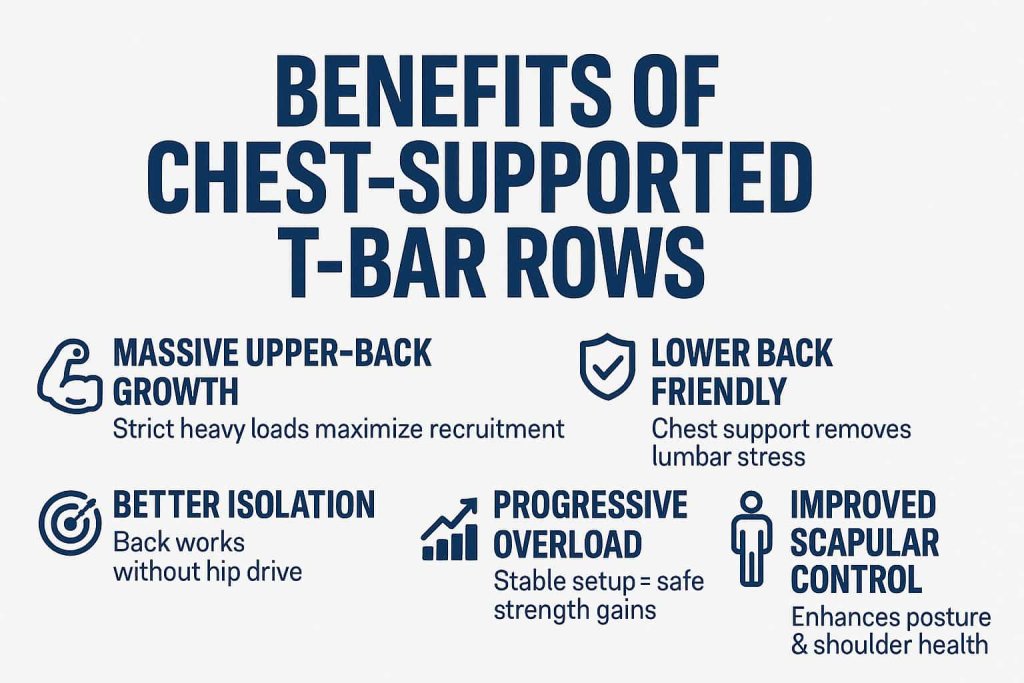The chest-supported T-bar row is one of the best exercises for building a thick, muscular upper back while minimizing strain on your lower back. Unlike bent-over rows, this variation keeps your torso supported, letting you lift heavier and focus directly on your lats, traps, and rhomboids.

This exercise is especially valuable if you want massive upper-back growth without risking lower back fatigue. In this guide, we’ll cover how to do it properly, muscles worked, benefits, common mistakes, programming tips, and FAQs — everything you need to know before adding it to your workout routine.
What Is the Chest-Supported T-Bar Row?
The chest-supported T-bar row is a row variation performed with your chest braced against a pad or incline bench while pulling a T-bar handle. This support eliminates momentum and reduces the involvement of your spinal erectors, placing the workload directly on your upper-back muscles.

- Equipment needed: T-bar machine or landmine bar setup with a chest pad/bench.
- Primary goal: Hypertrophy and thickness of the lats, traps, and rhomboids.
- Who it’s for: Beginners to advanced lifters who want maximum back development with less lower back strain.
Muscles Worked in Chest-Supported T-Bar Rows
This exercise is a compound pull that targets several major muscle groups:

- Latissimus Dorsi – main driver, adds width and thickness.
- Rhomboids – retract shoulder blades for postural strength.
- Trapezius (middle and lower fibers) – stabilizes scapula and builds upper-back density.
- Posterior Deltoids – assist in pulling motion.
- Biceps Brachii & Brachialis – secondary role, help with elbow flexion.
- Core (isometric) – maintains stability despite chest support.
Benefits of Chest-Supported T-Bar Rows
Why should you prioritize this exercise?

- Massive Upper-Back Growth – Heavy loads with strict form maximize muscle recruitment.
- Lower Back Friendly – Chest support removes pressure from the lumbar spine.
- Better Isolation – Minimal momentum ensures the back does the work, not the hips.
- Progressive Overload Made Easy – Stable setup lets you safely increase weight over time.
- Improved Scapular Control – Promotes full retraction and depression of shoulder blades, enhancing posture.
How to Perform the Chest-Supported T-Bar Row (Step-by-Step)
Follow these steps for proper form:
- Setup: Adjust the bench or pad so your chest is fully supported. Grip the handle (neutral, wide, or close).
- Start Position: Extend arms fully, shoulders protracted slightly. Keep chest down and neck neutral.
- Pull Phase: Drive elbows back toward your torso, squeezing shoulder blades together. Pull the bar to your mid-torso.
- Peak Contraction: Pause briefly and feel the squeeze in your upper back.
- Lower Phase: Slowly extend arms back to the starting position under control. Don’t let weights drop.
Pro Tip: Think about pulling with your elbows, not your hands, to maximize back engagement.
Programming: Sets, Reps & Frequency
The chest-supported T-bar row can be adapted for different goals:
| Goal | Sets | Reps | Rest |
|---|---|---|---|
| Strength | 3–5 | 5–8 | 2–3 min |
| Hypertrophy (size) | 3–4 | 8–12 | 90 sec |
| Endurance/finisher | 2–3 | 12–20 | 60 sec |
- Train 1–2x per week depending on your split.
- Pair with vertical pulls (pull-ups, lat pulldowns) for balanced back development.
- Progressive overload is key: add weight, reps, or tempo over time.
Common Mistakes to Avoid
Even with support, many lifters go wrong. Avoid these errors:
- ❌ Using too much weight → Leads to half reps and poor contraction.
- ❌ Letting shoulders round forward → Reduces back tension, increases risk.
- ❌ Pulling with arms only → Focus on elbow drive for true back engagement.
- ❌ Rushing reps → Lose time under tension, limiting growth.
- ❌ Incorrect bench height → Chest not fully supported, reducing stability.
Variations of the Chest-Supported T-Bar Row
Switching grips and handles changes muscle emphasis, stability demands, and even strength carryover. Below are the best variations to rotate into your training.
1. Close-Grip Neutral Handle T-Bar Row
Why it works: The close, neutral grip (palms facing each other) keeps your elbows tucked, emphasizing the lats and reducing shoulder stress.
Muscles worked: Lats, rhomboids, biceps.
How to do it:
- Use a narrow, neutral handle attachment.
- Row toward your lower chest or upper abs.
- Keep elbows close to your body.
Trainer Tip: Squeeze shoulder blades together at the top for maximum lat contraction.
2. Wide-Grip Handle T-Bar Row
Why it works: A wider grip shifts the focus to the traps, rear delts, and upper back, creating a thicker, more 3D look.
Muscles worked: Upper traps, rhomboids, posterior delts, lats.
How to do it:
- Use a wide grip attachment (like a lat pulldown bar).
- Pull the bar toward mid-chest, flaring elbows slightly outward.
- Keep chest firmly pressed to the pad.
Trainer Tip: Don’t overload the weight—control is key to avoid shoulder strain.
3. Single-Arm Chest-Supported Row
Why it works: Training one side at a time fixes imbalances and improves the mind-muscle connection. It also allows for a longer range of motion.
Muscles worked: Lats, traps, rear delts, biceps (unilaterally).
How to do it:
- Hold one handle with a dumbbell or cable attachment while keeping the other side free.
- Row through a full range, focusing on squeezing the lat.
- Keep torso stable—don’t twist.
Trainer Tip: Imagine pulling your elbow into your back pocket for better lat activation.
4. Incline Bench Dumbbell Row (Home-Friendly Alternative)
Why it works: No T-bar machine? An incline bench with dumbbells mimics the movement, making it accessible for home workouts.
Muscles worked: Lats, rhomboids, traps, biceps.
How to do it:
- Set a bench to a 30–45° incline.
- Lie chest-down with a dumbbell in each hand.
- Row dumbbells toward your ribcage.
Trainer Tip: Use lighter weights with strict control—this variation emphasizes form over load.
5. Isometric Holds at the Top
Why it works: Adding a 2–3 second pause at peak contraction increases time under tension, improving strength and muscle endurance.
Muscles worked: Entire upper back, especially rhomboids and lats.
How to do it:
- Perform a standard T-bar row.
- Hold the bar at the top (squeezing shoulder blades) for 2–3 seconds.
- Slowly lower under control.
Trainer Tip: Focus on engaging your mid-back, not just moving the weight.
Trainer Tips for Maximum Growth
- Warm up with light rows and band pull-aparts to prime scapula movement.
- Use lifting straps if grip is the limiting factor.
- Don’t bounce the weight; control the eccentric phase.
- Incorporate both supported and unsupported rows for total back strength.
- Track weights and reps to ensure progressive overload.
Who Should Avoid This Exercise?
While generally safe, it may not suit everyone:
- Individuals with chest injuries (pressure on sternum).
- Those with limited shoulder mobility if they cannot retract properly.
- Anyone without proper setup (risk of misalignment).
FAQs
Q1. Is the chest-supported T-bar row better than bent-over rows?
Not necessarily better — it isolates the back more and reduces lower back stress, but bent-over rows build total posterior chain strength. Use both for best results.
Q2. Can beginners do this exercise?
Yes, it’s beginner-friendly because the support helps maintain form. Start light and focus on technique.
Q3. What’s the best grip for lats?
A close, neutral grip emphasizes the lats more.
Q4. How often should I do this exercise?
1–2 times per week, depending on your program and recovery.
Q5. Do I need a T-bar machine?
No — you can use a landmine setup with a V-handle and incline bench.
Q6. Does it help posture?
Yes, by strengthening scapular retractors (rhomboids, mid traps), it helps correct slouching.
Conclusion
The chest-supported T-bar row is a must-have exercise for anyone serious about building a massive upper back. By removing lower-back strain and allowing strict form, it provides unmatched hypertrophy potential. Add it to your pull days, train with progressive overload, and watch your back grow thicker, wider, and stronger.
👉 Ready to upgrade your training? Start incorporating the chest-supported T-bar row into your next workout and feel the difference.
